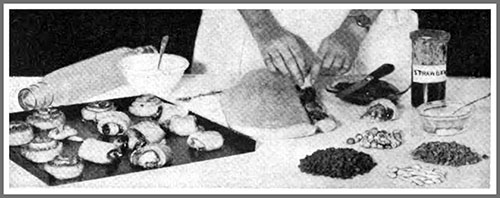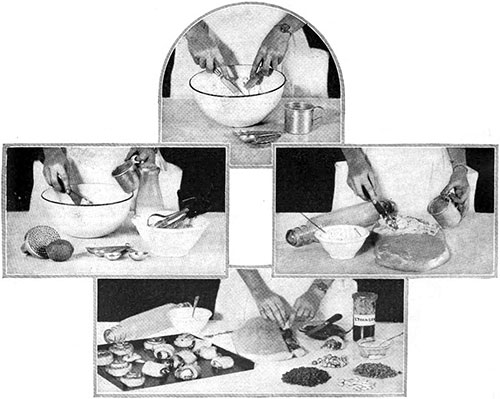Danish Pastry - 1920

What is Danish pastry? It is something new—an exquisite, tempting blending of sugar and spice and everything nice, wrapped up in or sprinkled over the top of, a delicious, short, crisp cake which is neither a puff-paste nor a bun, but a happy combination of both.
And any housewife who wishes to serve novel and unusual dainties at her teas and other festivities will find Danish pastry less costly than fine cake, more attractive than the daintiest of sandwiches, and newer than the French pastry so long in vogue. In addition to all these, she will derive infinite enjoyment in its making.
And now as to the pastry itself. The glossy little scrolls, the filled and decorated twists, and all the rest of the numerous assortments of Danish dainties are made upon one foundation which is simply cut and braided and twisted and decked out in as many ways as one may fancy.
So, when once the secret of this foundation is learned, the making of the most elaborate Danish pastry will become an easy matter.
There are just two essentials to be remembered in making Danish pastry:
First, everything must be cold—ingredients, bowls, rolling-pin, and other implements, the only warmth permitted in the whole process being the warm water used in softening the yeast.
The second essential is that the lightness and delicacy in the finished confection are not produced by the addition of more yeast, but by the rolling and folding in of butter or margarine, just as in puff-paste making.
So much for preliminaries, and now having our cold bowl and other things in readiness, let us proceed to the recipe for the pastry without further parley.
List of Ingredients
- one pint of milk,
- three eggs,
- one-half pound of butter or margarine,
- one yeast cake,
- one cup of sugar,
- one and one-half teaspoons of salt,
- the grated rind of one lemon,
- a pinch of mace, and flour enough to make a stiff dough, about nine cups.
Directions

Making Danish Pastry (Top Down): Cut one-half of the butter into the flour until the mixture is like a coarse meal; Then add the remaining ingredients; Spread the other half of the butter on the dough, folding it in carefully; and Chill for one hour then roll and cut into shapes.
- Before beginning operations, divide the butter in two equal parts. Margarine may be used satisfactorily, but butter will give a far more delicious flavor, so it is advisable to use it if possible.
- Wash the butter through cold water, working it thoroughly with a wooden spoon which has been scalded first, then placed in very cold water for a few minutes to chill.
- When the butter has become pliable and yielding, and even trace of salt is removed, wrap each portion in a cloth, press out all the moisture, and place next to the ice to become firm and cold.
- Sift three cups of the flour with the salt and mace.
- Soften the yeast in one-fourth cup of lukewarm water.
- Rub half the butter into the flour, either with two knives or the fingers, until the mixture is like coarse meal.
- Beat the eggs to a stiff, light foam and stir them, with the sugar, milk, lemon peel, and yeast, into the flour.
- Beat very hard, adding more flour gradually until the mixture becomes too stiff to handle with a spoon.
- About nine cups of flour will be needed.
- Turn the dough on a well-floured board and knead it vigorously for ten minutes.
- Then, return the dough to the bowl, cover with a cloth, and place in the refrigerator for ten to fifteen minutes to ripen and chill.
- Next, roll the dough out in a long, narrow strip half an inch thick.
- Bring out the second piece of butter, cut into small pieces, arrange these on the lower half of the sheet of dough, and bring the other half over it.
- Fold the ends of the dough one over the other under the center, making a compact square of it with the butter inside.
- Tap the dough gently with the rolling pin to flatten it slightly, and roll out into a long, narrow strip. Then fold again as before.
- Now, turn the block of dough half-way around and roll once more; fold again and roll; then fold and place in a cold bowl, cover with a cloth, and tuck away in a refrigerator for one hour.
Suggestions for Better Danish Pastry
Never place the pastry directly on the ice or in a temperature of less than thirty-five or forty degrees, as there is danger of lessening the leavening qualities of the yeast by so doing. While the dough is chilling, the decorations, fillings, and icings may be prepared.
A dollar or two will buy a nice supply of accessories which will be sufficient for several baking: an ounce or two of shelled pistachio nuts, a small bottle of maraschino cherries, a bit of angelica, some shelled almonds and pecans, with a little-candied citron or orange-peel.
A few bottles of vegetable coloring may be added to the supply, green, yellow, and red being the most popular. Vanilla, almond, orange, lemon, and perhaps pistachio extract give a delicate flavor, but failing everything but the vanilla the pastries will be delicious and extremely good to look upon.
Glazing and Fillings
Apricot Glaze is used to giving that desirable varnished appearance which is so noticeable on the most expensive pastries. Melted jelly will give a good effect also, and either the glaze or the jelly should be applied to the finished pastries with a small paint-brush.
Then return the pastries to a cool oven for a few minutes to dry. You may make the Apricot Glaze yourself as follows: Soak half a pound of dried apricots in cold water for several hours; then cook to a pulp. Rub through a fine sieve, adding more water if too thick.
Then measure and return to the fire. Allow one-half cupful of sugar to each cup of pulp and cook until thick and syrupy, stirring constantly all the while. Pour into a jar and keep in a cool place.
For Lemon Cream, which is very delicious as a filling for the pastry, grate one lemon and squeeze the juice from it. Beat one egg, mix with the lemon juice, add one tablespoon of butter or margarine, and one cup of sugar. Mix well and cook over hot water until thick. Cool before using.
- For Vanilla Cream, make a boiled custard thickened with cornstarch.
- For Hazelnut Cream, add to the Vanilla Cream shelled filberts roasted in a hot oven for fifteen minutes, then ground fine.
- Caramel Cream is made by adding one tablespoon of sugar, melted to the caramel stage, to the Vanilla Cream.
- For icing, mix confectioner's sugar with cold water to form a paste, coloring and flavoring it as desired.
By the time these preparations have been completed, the pastry will be sufficiently chilled and ready to roll and form into shape. Divide the dough into two parts, placing one part in the refrigerator to prevent it to become soft before using. Roll the pastry into a sheet one-fourth inch thick.
Pretzels, Wreaths, Scrolls, and Snails
For pretzels, wreaths, scrolls, and snails cut the dough in strips one inch wide, using a sharp knife that does not drag the pastry or a pastry wheel. The strips should be about seven inches long.
- For the snails, spread the strips with any of the fillings, roll them up closely, a little higher in the center than on the edges, and brush over with the yolk of one egg beaten with two tablespoonfuls of milk.
- Pretzels, wreaths, scrolls, and figure eights are made by twisting the strips of dough lightly from opposite ends, then forming them into the desired shape. Brush the ends of the rings and wreaths with the egg-and-milk wash before fastening them together; this insures their remaining in shape when baked.
- Braids are made by cutting the pastry into strips and plaiting them in three or four strands, then cut into pieces three inches long.
- Tea-rings are made by braiding strips one-half inch wide in three strands or twisting in two strands, then fastening together like the wreaths.
- Kipfels are made by spreading a strip of pastry with filling, rolling it up like the snails, then clipping the outside ends vertically with a sharp knife or shears.
- Envelops are squares of pastry rolled one-fourth inch thick and cut four to five inches square. The pastry is then spread with filling, the corners turned toward the center and pressed lightly into shape.
- Tartlets are made by lining rather flat scalloped pans with the pastry rolled thin, and filling the centers with jam or fruit, either fresh or canned.
- Cinnamon chips are made by sprinkling the rolled dough with cinnamon and sugar; then roll up like a jelly roll, cut into slices, and lay with the cut side up on the baking sheet.
When all the dough has been made into form and brushed with egg and milk, set to rise in a moderately warm temperature for about two hours.
Then place in the refrigerator for overnight. By morning the pastry should be well raised and light. Bake in a 350° F. oven for twenty-five minutes or until the pastry is a golden brown in color.
Hints for the Baker
Here in the Institute, we found it best to mix the dough in the late afternoon, form it into shapes, and allow it to rise, then place it in the refrigerator overnight. Be sure that the refrigerator is not cooler than 40 degrees. When the pastries have been baked and allowed to cool, they are ready for decoration.
Katherine Campion, "Danish Pastry," in Good Housekeeping, New York: International Magazine Company, Vol. LXXI, No. 5, December 1920, p. 70-71.
